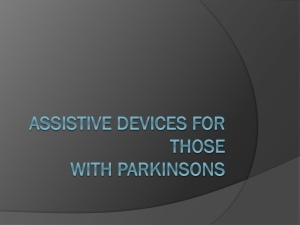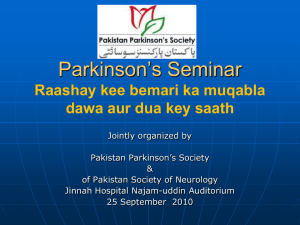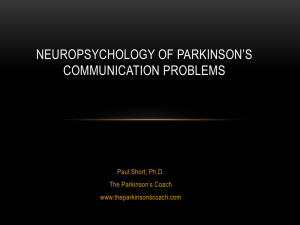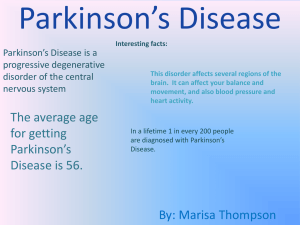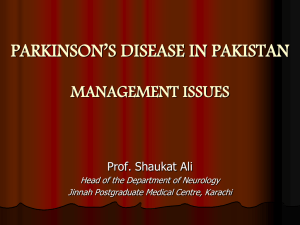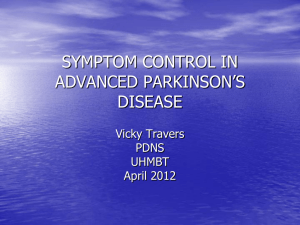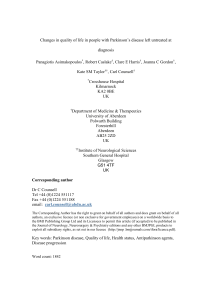Summary of recommendations
advertisement
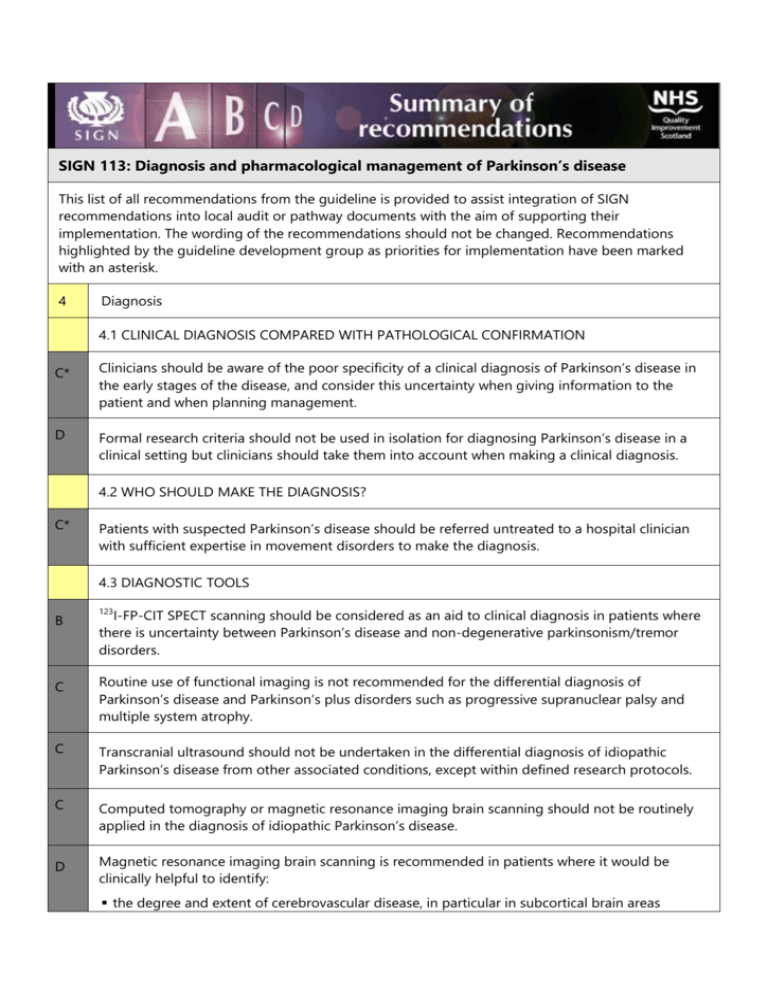
SIGN 113: Diagnosis and pharmacological management of Parkinson’s disease This list of all recommendations from the guideline is provided to assist integration of SIGN recommendations into local audit or pathway documents with the aim of supporting their implementation. The wording of the recommendations should not be changed. Recommendations highlighted by the guideline development group as priorities for implementation have been marked with an asterisk. 4 Diagnosis 4.1 CLINICAL DIAGNOSIS COMPARED WITH PATHOLOGICAL CONFIRMATION C* Clinicians should be aware of the poor specificity of a clinical diagnosis of Parkinson’s disease in the early stages of the disease, and consider this uncertainty when giving information to the patient and when planning management. D Formal research criteria should not be used in isolation for diagnosing Parkinson’s disease in a clinical setting but clinicians should take them into account when making a clinical diagnosis. 4.2 WHO SHOULD MAKE THE DIAGNOSIS? C* Patients with suspected Parkinson’s disease should be referred untreated to a hospital clinician with sufficient expertise in movement disorders to make the diagnosis. 4.3 DIAGNOSTIC TOOLS B 123 I-FP-CIT SPECT scanning should be considered as an aid to clinical diagnosis in patients where there is uncertainty between Parkinson’s disease and non-degenerative parkinsonism/tremor disorders. C Routine use of functional imaging is not recommended for the differential diagnosis of Parkinson’s disease and Parkinson’s plus disorders such as progressive supranuclear palsy and multiple system atrophy. C Transcranial ultrasound should not be undertaken in the differential diagnosis of idiopathic Parkinson’s disease from other associated conditions, except within defined research protocols. C Computed tomography or magnetic resonance imaging brain scanning should not be routinely applied in the diagnosis of idiopathic Parkinson’s disease. D Magnetic resonance imaging brain scanning is recommended in patients where it would be clinically helpful to identify: the degree and extent of cerebrovascular disease, in particular in subcortical brain areas including the basal ganglia, to differentiate idiopathic Parkinson’s disease from vascular parkinsonism the degree and distribution of brain atrophy, in patients with features suggesting a Parkinson’s plus disorder. D Computed tomography or magnetic resonance imaging brain scanning is recommended in patients where it would be clinically helpful to identify: the presence of a structural lesion or lesions which may cause or contribute to parkinsonism/gait disorder/tremor. A Acute challenge testing is not recommended in the diagnosis of Parkinson’s disease. Patients with suspected Parkinson’s disease should be considered for a trial of chronic levodopa treatment. B Objective olfactory testing is not recommended in the diagnosis of Parkinson’s disease. 4.4 DIAGNOSING DEPRESSION IN PATIENTS WITH PARKINSON’S DISEASE C Self-rating or clinician-rated scales may be used to screen for depression in patients with Parkinson’s disease. 5 Pharmacological management 5.1 DRUG EFFICACY IN EARLY DISEASE A* Patients with early Parkinson’s disease and motor symptoms may be considered for treatment with levodopa in combination with a dopa decarboxylase inhibitor. A* Patients with early Parkinson’s disease and motor symptoms may be considered for treatment with oral/transdermal dopamine agonists. B* Ergot derived dopamine agonists should not be used as first line treatment for Parkinson’s disease. A* Patients should be warned about the potential for dopamine agonists to cause impulse control disorders, excessive daytime somnolence and the implications for driving/operating machinery. A* Patients with early Parkinson’s disease and motor symptoms may be considered for treatment with monoamine oxidase B inhibitors. B* Anticholinergic drugs should not be used as first line treatment in patients with Parkinson’s disease. 5.5 PHARMACOLOGICAL MANAGEMENT OF MOTOR COMPLICATIONS A* Monoamine oxidase B inhibitors may be considered for the treatment of motor complications in patients with advanced Parkinson’s disease. A* Dopamine agonists (oral or transdermal) may be considered for the management of complications in patients with advanced Parkinson’s disease. The non-ergot agonists (ropinirole, pramipexole, and rotigotine) are preferable to the ergot agonists. A Intermittent subcutaneous apomorphine may be considered for the reduction in ‘off’ time in patients with advanced Parkinson’s disease. D Subcutaneous apomorphine infusions may be considered for the management of severe motor complications, but should only be provided in units with sufficient experience and resources. A* Catechol-o-methyl transferase inhibitors may be considered for the reduction in ‘off’ time in patients with advanced Parkinson’s disease who have motor fluctuations. 5.6 MANAGEMENT OF DAYTIME SLEEPINESS A Modafinil and melatonin are not recommended for the management of excessive daytime sleepiness associated with Parkinson’s disease. 5.7 ORAL SUPPLEMENTS A Tocopherol is not recommended for neuroprotection in patients with early Parkinson’s disease. 5.9 GAIT DISORDERS B Injection of botulinum toxin into the calf muscles of people with Parkinson’s disease who have significant gait freezing are not recommended. 5.10 PHARMACOLOGICAL TREATMENT OF MENTAL HEALTH DISORDERS A B Patients with psychosis in Parkinson’s disease should be considered for treatment with low-dose clozapine and undergo weekly monitoring for the first 18 weeks of treatment followed by fortnightly monitoring for the first year and then monthly thereafter. Where weekly monitoring of blood is not possible on a consistent basis low-dose quetiapine should be considered as an alternative antipsychotic for the treatment of patients with psychosis in Parkinson’s disease.


